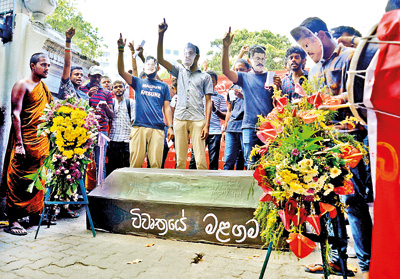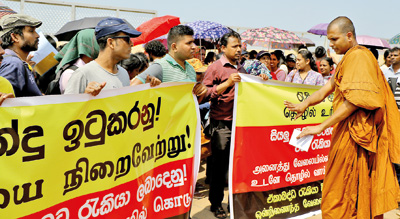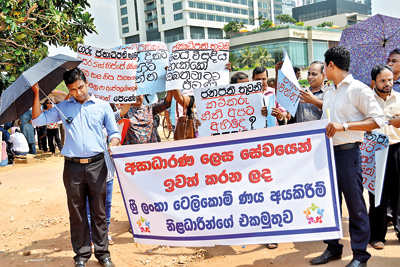News
Proliferating protests put President’s policies to the test
The wave of protests which the previous Government struggled to deal with is continuing under President Gotabaya Rajapaksa, too, with opposition critics claiming that it reflects the rising public discontent with his policies.

The IUSF went on protest this week to demand for Open University (OUSL) course fees to be reduced. They claim the fees have risen annually by 10% since 2015. Pic by Eshan Fernando
According to figures provided by police, there have been 38 public protests in Colombo alone from January 1 to February 11 this year. By Friday, that number had increased to nearly 50.
Government politicians say they will not be able to resolve many of the issues the protesters raise until a proper Budget is presented after the general elections.
The Government, meanwhile, in a bid to minimise public inconvenience, has designated a site opposite the Presidential Secretariat for protests. This so-called “Agitation Site” now attracts a large number of protesters, though protests also continue to be held elsewhere.
Despite the large number of protests, there have been no major clashes between protesters and police, unlike in previous years. The Government claims police have been instructed to exercise maximum restraint when dealing with protesters.
On Friday, there were about half a dozen protests at the Agitation Site and elsewhere in Colombo. The Archaeological Employees’ Union, employees from the Debt Recovery Section of Sri Lanka Telecom and depositors of the Finance Company (TFC) were among those who protested opposite the Presidential Secretariat, while teacher unions held a protest opposite the Fort Railway Station. Relatives of the missing people, meanwhile, marched to Temple Trees from Viharamahadevi Park.
Drawing much media and public attention were protests launched by those have lost their government jobs after the new government came to office. They were recruited on contract basis during the previous Government but their contracts were not extended by the new government.
Among them were All-Island Dengue Prevention Assistants’ Union members. When they were at the Agitation Site, they had a surprise visitor – President Gotabaya Rajapaksa. The protesters dispersed after the President told them that they would be given permanent employment under the Government’s programme to provide jobs to 100,000 people.

The Inter University Students’ Federation (IUSF) has continued its practice of engaging in protest marches. Pic by Chathura S. Kodikara
On Friday, the Sunday Times spoke to another such group of protesters who claim their services at the Archaeology Department had been unfairly terminated. The protesters have been camping out at the agitation site since Monday after they united under a new union – the Archaeological Employees’ Union.
Their spokesman Dhammika Sampath explained that their services had been terminated from January 31. They were recruited to the Central Cultural Fund (CCF) on a contract basis in November 2017 for a one year. These contracts were later extended by the previous Government on the understanding that the employees would be absorbed into the Archaeology Department as permanent employees when vacancies occurred. This, however, did not happen as the new Government decided to terminate their services at the end of January.
“This is completely unjust as the Archaeology Department has already gazetted 1,865 vacancies. These include 1000 vacancies for watchers and 865 for archaeology assistants. We have been serving the department indirectly for more than two years as contract workers of the CCF. We have looked after valuable heritage sites that are part of our history,” the spokesman said.
Sampath and nine others launched a fast-unto-death at the agitation site after they did not receive a positive response from the Government. Two of those who took part required hospital treatment. One was later discharged, but the other was still in hospital on Friday. The fast and the protest, though, were officially called off on Friday afternoon after representatives of the protesters met President Rajapaksa’s Private Secretary Sugeeshwara Bandara.
Mr Sampath said Mr. Bandara had assured the protesters that a section of them would be absorbed into the Archaeology Department by next Thursday. “If this does not happen, we are prepared to take far more stringent action,” he warned.
The United National Party (UNP) claims protests have increased due to the current Government’s moves to sack employees legally recruited into the Government service.

Employees from the Debt Recovery Section of Sri Lanka Telecom were among those who protested opposite the Presidential Secretariat, on Friday. Pic by M.D. Nissanka
“We have seen protests by employees who were kicked out from the Central Cultural Fund, the Sri Lanka Transport Board, Samurdhi Authority, Railways and many others in recent weeks. The Government has also decided to halt wage hikes that we approved and has also gone and stopped the pension increase we approved for 580,000 pensioners. All this shows the Government’s incompetence and mismanagement of the economy. No wonder people are protesting,” said UNP Parliamentarian J.C. Alawathuwala.
Co-Cabinet spokesman and Higher Education Minister Bandula Gunawardena, though, attributed the increase in protests to the freedom they enjoyed now. “The people no longer feared being attacked if they protested.”
“We saw how the previous Government responded to protests: with tear gas and baton charges. Have you seen any such incident under our government?” he asked.
Mr Gunawardena acknowledged the large number of protests by those who have lost their jobs. But he claimed most of them had been recruited without following the proper process. “Because of the previous Government’s actions, we are now encountering legal issues with regard to salaries, transfers and promotions.”
The minister argued it was unfair for protesters to expect a Government that will be in power for only a few months to resolve all these problems. “We only have a Vote on Account to cover the period until the general elections which are just weeks away. We will need to present a proper Budget to resolve these issues and that can only happen after the election,” he said.
| Agitation Site draws bouquets, brickbats and brisk business | |
| The Government’s decision to set up an “Agitation Site” for protesters to voice their demands has drawn both praise and criticism. Some lauded the move on the grounds that it would lessen disruption to public life, while those who oppose it stressed that the idea of agitation itself is disruption and attempts to confine it to a single location is undemocratic. The so-called “Agitation Site” is located on a plot of land belonging to the Ministry of Defence. The location does now attract different groups of protesters and it’s not unusual to see multiple protests taking place there at the same time. This was the case on Friday afternoon, when three groups of protesters were at the site. They were from the Archaeological Employees’ Union, employees from the Debt Recovery Section of Sri Lanka Telecom and depositors of The Finance Company. The site itself is almost bare, save for a lone tree that stands close to Galle Road. The afternoon heat is incredibly oppressive and both protesters and police who are supposed to guard them can be seen frequently seen clustered together under the tree. Trash cans at the site are full of plastic water bottles. The site has also attracted enterprising vendors. Ice cream sellers, vendors selling bottles filled with cool water and those selling “saaravita” were doing brisk business among the protesters. Uniformed police, both male and female, were watching over the protesters. Black clad members of the police riot squad were also there, with some clutching tear gas guns and shields. There were minor scuffles when The Finance depositors tried to make their way unto Galle Road and proceed to the Central Bank. There were, however, no major clashes. Tharindu Kosala, an employee from SLT’s Debt Recovery Section, said this was the first time their group was protesting at the site. He said they represented a group of 65 employees who had been denied their EPF/ETF benefits by SLT administration. “The Labour Department ordered SLT to pay us the benefits, but they went to the Court of Appeal, which ruled in favour of the Labour Department. SLT, however, had sacked us in the meantime and has appealed the Appeals Court decision in the Supreme Court. We have been out of work for five years now.” Mr Kosala said they chose to come to the agitation site as they felt that only the President could provide a solution for them. An Archaeological Employees’ Union member said they too had chosen the location to protest as they felt the authorities would not be able to ignore them there. “However, I don’t think this is very good for democracy or people’s rights,” he added. The Inter University Students’ Federation (IUSF), meanwhile, has continued its practice of engaging in protest marches. Its Convenor Ven Rathkarawwe Jinarathana Thera pointed out that they were mostly interested in marching to the Higher Education Ministry premises since this was where decisions related to higher education were generally made. Ven. Jinarathana Thera though, dismissed the Government’s move to designate an agitation site for protests. “Who are they to tell us where to protest? We take maximum effort to keep inconvenience caused to the public to a minimum but some inconvenience is inevitable in a protest. We will not be bullied into designated spaces,” he added. |

